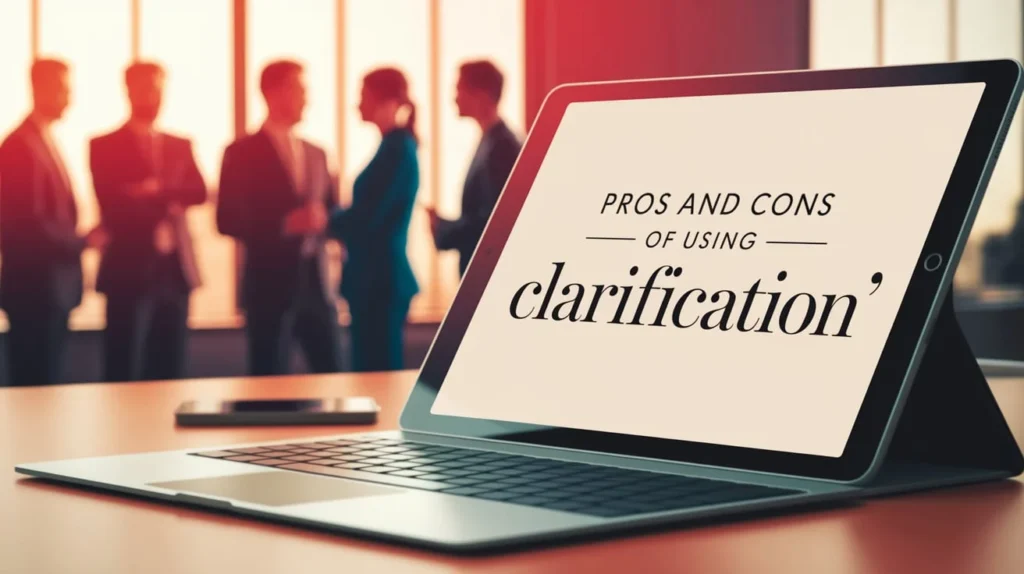When it comes to communication, the way we phrase things matters. Whether you’re explaining a concept to a colleague, asking for more details from a friend, or trying to make sure you’re on the same page, finding the right words can really make a difference. Sometimes, the word clarification can sound a bit too stiff or formal, but don’t worry — there are plenty of other ways to express the same idea with warmth and care!
In this article, we’re going to explore 20 other ways to say ‘clarification’ so you can communicate more thoughtfully, and with a personal touch.
What Does “Clarification” Mean?
Before we dive into all these awesome alternatives, let’s quickly break down what clarification really means. Simply put, it’s when you ask someone to explain something in more detail or make it easier to understand. It’s the “Hey, I didn’t quite get that, can you explain again?” moment in conversations.
A lot of the time, we might be unclear about a point and need someone to clarify what they meant. But instead of just using the word “clarification,” we can express this idea in different ways, making our language feel warmer and more engaging.
Is It Professional/Polite to Say ‘Clarification’?
Using the word clarification in professional emails or conversations is absolutely fine. However, depending on your tone and how well you know the person, it might come off as a little stiff or overly formal. It’s important to be aware of your audience and choose your words carefully to match the tone you want to convey.
For instance, in a corporate setting where you need to ask for further information, “Could you please provide clarification?” might feel appropriate. But if you’re having a casual conversation with a friend, you might want to switch it up a bit and go for something friendlier like “Can you explain that again?”
Pros and Cons of Using ‘Clarification’

Like any word, clarification has its advantages and drawbacks. Let’s look at the pros and cons of using it.
Pros:
- Clear and direct.
- Often seen as professional.
- It’s easy to understand.
Cons:
- Can sound stiff or impersonal.
- Doesn’t always feel warm or friendly.
- Overused in formal writing and communication.
Synonyms for ‘Clarification’
- Explanation
- Elucidation
- Insight
- Interpretation
- Clarifying Question
- Further Explanation
- Details
- Review
- Breakdown
- Refinement
- Further Information
- Guidance
- Help
- Assistance
- Suggestion
- Support
- Idea
- Input
- Analysis
- Inquiry
1. Explanation
An explanation is one of the simplest and most common alternatives to clarification. It’s a straightforward way to ask for a more detailed description or breakdown of something.
Scenario Example:
Subject: Request for Explanation
Dear [Name],
I was hoping you could provide a bit more explanation on the new project details. I’m not quite sure I fully understand all of the requirements yet.
Best regards,
[Your Name]
Best Use:
Use when you’re seeking a simple, clear breakdown of something.
Additional Note:
It’s a friendly and approachable option without being too formal. Explanation works in both casual and professional contexts.
2. Elucidation
Now, here’s one that sounds a bit more academic: elucidation. It’s a formal way of asking for a clearer explanation or interpretation, often used in more professional or scholarly settings.
Scenario Example:
Subject: Request for Elucidation
Dear [Name],
Could you please provide some elucidation on the report? I’m unclear about how we’re measuring the data.
Thank you!
[Your Name]
Best Use:
Ideal for formal or academic contexts when you want to sound professional.
Additional Note:
Elucidation is a bit more specific than an explanation and has a scholarly tone to it.
3. Insight
When you need someone to offer a deeper understanding or perspective, asking for insight can sound more personal and thoughtful.
Scenario Example:
Subject: Seeking Insight
Hi [Name],
Could you share some insight into the decision-making process behind the new strategy? I’d love to understand the reasoning more thoroughly.
Best,
[Your Name]
Best Use:
Use insight when you’re seeking more profound or thoughtful input, especially in a professional or leadership context.
Additional Note:
It’s less about specific facts and more about understanding someone’s point of view or perspective.
4. Interpretation
If you need someone to explain something in a way that makes it easier to understand, interpretation can be a good alternative to clarification.
Scenario Example:
Subject: Request for Interpretation
Dear [Name],
I’d appreciate your interpretation of the data presented in the report. Could you break down the main takeaways?
Thanks so much!
[Your Name]
Best Use:
This is great when you need to make sense of complex information or need help understanding a specific viewpoint.
Additional Note:
It’s a bit more personal than explanation, as it suggests the person is helping you see something from their perspective.
5. Clarifying Question
When you’re simply asking for a follow-up question to get better understanding, you might use clarifying question instead of just saying “Can you clarify?”
Scenario Example:
Subject: Clarifying Question
Hi [Name],
I have a clarifying question about the report. Could you confirm the date for the next meeting?
Thanks,
[Your Name]
Best Use:
Good for situations where you need a quick follow-up or confirmation on something that’s unclear.
Additional Note:
It’s often used in casual conversations or when there’s room for light discussion.
6. Further Explanation
Sometimes you don’t need a complete breakdown, but just a little more explanation to fill in the gaps.
Scenario Example:
Subject: Further Explanation Needed
Hello [Name],
Would you mind providing further explanation on the new guidelines? I’m not sure I fully understand the final step.
Best,
[Your Name]
Best Use:
Use when you’re close to understanding but need that extra bit of information to wrap things up.
Additional Note:
It’s a bit softer and shows you’re not totally lost but just need more clarity.
7. Details
Asking for more details is an easy way to request more information in a way that’s polite and approachable.
Scenario Example:
Subject: Request for More Details
Dear [Name],
I’d love it if you could send over more details on the project timeline. We’re finalizing our schedules and want to make sure we’re aligned.
Thanks,
[Your Name]
Best Use:
Perfect when you need specifics or are looking for more granular information.
Additional Note:
Details is great for less formal settings or quick email exchanges.
8. Review
When asking for someone’s help in going over something again, review can be a nice, neutral way to ask for more clarity without sounding too demanding.
Scenario Example:
Subject: Request for Review
Hi [Name],
Could you please review the document again and let me know if everything looks good?
Thanks,
[Your Name]
Best Use:
Great for casual and professional settings when you need someone to go over something a bit more carefully.
Additional Note:
It’s a relaxed, non-intrusive way of asking for more information.
9. Breakdown
Sometimes, you need someone to give you a simple breakdown of something complicated. This is less formal but still effective.
Scenario Example:
Subject: Request for Breakdown
Dear [Name],
Could you give me a quick breakdown of how the budget allocations work? I’m still trying to understand the full process.
Best,
[Your Name]
Best Use:
Use when you need to simplify something that’s a bit too complex to grasp all at once.
Additional Note:
It’s a very friendly and approachable term that works well in casual settings.
10. Refinement
If someone’s initial explanation was close but not quite on point, asking for a refinement can gently ask for more precision.
Scenario Example:
Subject: Request for Refinement
Hi [Name],
I think I understand the general idea, but could you offer a little refinement on how to handle this specific case?
Thanks a lot!
[Your Name]
Best Use:
Ideal for situations where the initial explanation is almost there, but you need a few more tweaks for clarity.
Additional Note:
It’s a polite way of asking someone to polish their explanation or provide a more exact version.
11. Further Information
Sometimes, a little more information is all you need to fully grasp something. Asking for further information makes your request sound polite and professional.
Scenario Example:
Subject: Request for Further Information
Dear [Name],
I appreciate the initial overview, but could you provide further information on the budget allocations? I want to ensure we’re aligned on all the details.
Best,
[Your Name]
Best Use:
Works well in professional settings when you need additional details without sounding too demanding.
Additional Note:
This phrase is clear, direct, and widely used in business emails.
12. Guidance
If you need someone to help you understand something better, asking for guidance is a great way to frame it. It suggests that you value the other person’s expertise.
Scenario Example:
Subject: Seeking Guidance
Hi [Name],
I’m working on the new project proposal and would love some guidance on structuring the financial section. Could we discuss this sometime this week?
Best,
[Your Name]
Best Use:
Perfect for when you need expertise or mentorship.
Additional Note:
This wording feels respectful and acknowledges the other person’s knowledge.
13. Help
When in doubt, just ask for help! It’s simple, clear, and effective.
Scenario Example:
Subject: A Quick Request for Help
Hi [Name],
I need a little help understanding the new scheduling system. Do you have a moment to walk me through it?
Thanks!
[Your Name]
Best Use:
Works well in casual conversations or informal work settings.
Additional Note:
This keeps your request light and friendly without overcomplicating it.
14. Assistance
A more formal way to ask for help is to request assistance. It’s polite and works well in professional contexts.
Scenario Example:
Subject: Assistance Required
Dear [Name],
Would you be able to provide some assistance with the new software integration? I’d appreciate your insights.
Best,
[Your Name]
Best Use:
Great for workplace settings when you need structured support.
Additional Note:
It’s professional but doesn’t sound too distant.
15. Suggestion
If you’re open to ideas and not just looking for an explanation, asking for a suggestion can be a great approach.
Scenario Example:
Subject: Looking for Your Suggestion
Hi [Name],
I’d love to hear your suggestions on how we can improve the onboarding process. Let me know your thoughts!
Thanks,
[Your Name]
Best Use:
Best when you’re looking for ideas rather than just clarity.
Additional Note:
This keeps the conversation open-ended and encourages discussion.
16. Support
Sometimes, you need more than just an explanation—you need support in handling something.
Scenario Example:
Subject: Request for Support
Dear [Name],
Could you provide some support in setting up the new project tracking tool? I want to make sure I’m using it correctly.
Best,
[Your Name]
Best Use:
Great when you need active help rather than just an explanation.
Additional Note:
Using “support” makes it clear that you might need ongoing help.
17. Idea
When you’re open to creative input rather than just clarity, asking for an idea is a nice alternative.
Scenario Example:
Subject: Brainstorming Ideas
Hi [Name],
I’m trying to refine our marketing approach. Do you have any ideas on how we can make the campaign more engaging?
Best,
[Your Name]
Best Use:
Perfect when you’re looking for creative input.
Additional Note:
This encourages collaboration and makes the other person feel valued.
18. Input
If you need someone’s perspective or feedback, asking for input is a good way to go.
Scenario Example:
Subject: Request for Your Input
Dear [Name],
I’d love to get your input on the new client proposal before we finalize it. Let me know your thoughts!
Best,
[Your Name]
Best Use:
Best when you need constructive feedback.
Additional Note:
This makes it sound like you’re involving the person rather than just seeking an explanation.
19. Analysis
For more in-depth explanations, asking for an analysis is a strong option.
Scenario Example:
Subject: Request for Analysis
Dear [Name],
Could you provide an analysis of the recent survey results? I’d love to understand the key trends.
Best,
[Your Name]
Best Use:
Works well when asking for data-driven explanations.
Additional Note:
This suggests a deeper level of understanding rather than just a surface explanation.
20. Inquiry
If you want to phrase your request formally, using inquiry can add a professional touch.
Scenario Example:
Subject: Inquiry Regarding Project Scope
Dear [Name],
I had an inquiry about the scope of the upcoming project. Could we schedule a quick call to go over the details?
Best,
[Your Name]
Best Use:
Great for formal or business settings.
Additional Note:
This keeps your request professional and structured.
Conclusion
Finding the right way to ask for clarification can make your communication feel more natural, friendly, and effective. Whether you choose explanation, insight, support, or analysis, each alternative allows you to tailor your message based on the situation.















